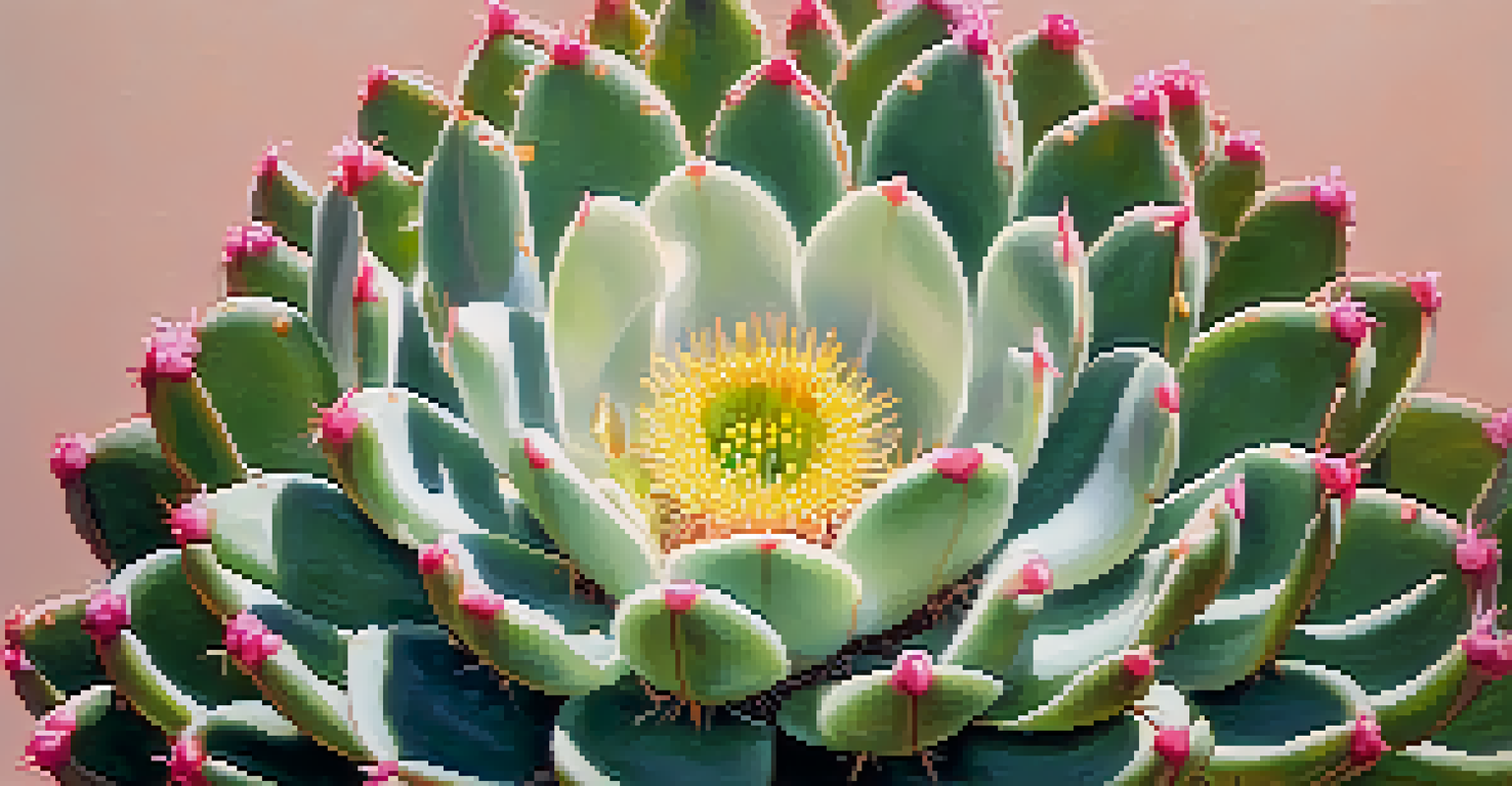Exploring the Ethnobotanical Use of Peyote in Healing Practices

Understanding Peyote: A Brief Overview
Peyote, scientifically known as Lophophora williamsii, is a small cactus native to Mexico and the southwestern United States. This cactus has been used for centuries in various Indigenous cultures for its psychoactive properties. The active compound, mescaline, is responsible for the profound spiritual and healing experiences reported by those who use Peyote.
The use of Peyote is not just about the substance itself but about the connections we form with each other and the spiritual journey we undertake.
Traditionally, Peyote is consumed during ceremonial rituals, often led by a shaman or spiritual guide. These ceremonies can last several hours, during which participants seek connection, understanding, and healing. The experience can be both introspective and communal, emphasizing the importance of shared healing within a community.
Understanding the cultural context of Peyote is essential, as its use is deeply rooted in Indigenous traditions. For many, it’s not merely a substance for recreation but a sacred tool in their spiritual arsenal, highlighting the need to respect and honor these practices.
Cultural Significance of Peyote in Indigenous Practices
For Indigenous peoples, Peyote serves as a bridge between the physical and spiritual worlds. It is often used in rites of passage, healing ceremonies, and spiritual gatherings, emphasizing its role as a facilitator of vision and insight. These practices are essential for maintaining cultural identity and continuity.

The Native American Church, which emerged in the late 19th century, is one of the most prominent organizations advocating for the legal use of Peyote. This church integrates Christian beliefs with Indigenous practices, using Peyote as a sacrament. For its members, the cactus is seen as a gift from the Creator, providing guidance and healing.
Peyote's Cultural Importance
Peyote is a sacred element in Indigenous practices, serving as a bridge between the physical and spiritual worlds.
Moreover, the rituals surrounding Peyote use foster community bonds and support systems. Participants share their experiences, reinforcing social ties and collective healing, which can be especially crucial for those facing trauma or loss.
The Healing Properties of Peyote
Peyote has been reported to offer various therapeutic benefits, particularly in addressing mental health issues such as depression and anxiety. The mescaline within Peyote can induce altered states of consciousness, allowing users to confront and process difficult emotions. This can lead to significant breakthroughs in personal healing.
Psychedelics can serve as catalysts for healing, providing insights that are often hidden in the shadows of our minds.
Studies have shown that psychedelics, including mescaline, can promote neuroplasticity—the brain's ability to reorganize itself by forming new neural connections. This effect can be particularly beneficial for individuals dealing with trauma, as it can facilitate new perspectives and emotional healing.
However, it’s essential to approach Peyote with caution, as it is not a panacea. Proper guidance and a controlled environment are crucial for a positive experience, which is why traditional ceremonies led by experienced shamans are so important.
Modern Research and Peyote: Bridging Tradition and Science
In recent years, there’s been a resurgence of interest in the medicinal properties of Peyote, prompting scientific research into its effects. Studies are exploring how mescaline can be integrated into therapeutic settings, providing insights into its potential for addiction treatment and mental health support. This research often seeks to validate traditional knowledge through empirical evidence.
Researchers are also examining the historical and cultural contexts of Peyote use, aiming to understand how these factors contribute to its healing effects. By combining Indigenous wisdom with modern science, there’s potential for a more holistic approach to healing, respecting both cultural heritage and scientific integrity.
Therapeutic Potential of Peyote
Research indicates that Peyote, particularly its active compound mescaline, may offer therapeutic benefits for mental health issues such as depression and anxiety.
As the stigma surrounding psychedelics begins to fade, Peyote may find its place within the broader conversation about alternative medicine. This shift could pave the way for greater acceptance of traditional practices alongside scientific advancements.
Legal Status of Peyote and Its Implications
The legal status of Peyote varies significantly across regions, often complicating its use in healing practices. In the United States, Peyote is classified as a Schedule I controlled substance, making it illegal to possess or use outside of specific religious contexts. However, members of the Native American Church are allowed to use it in their ceremonies, a unique provision reflecting its cultural significance.
This legal framework highlights the ongoing tension between Indigenous rights and state regulations. Many advocates argue for the protection of traditional practices, emphasizing that Peyote is not just a drug but a sacred element of their spirituality and culture. The fight for legal recognition and protection continues, as Indigenous communities seek to preserve their practices.
As discussions about drug reform evolve, there’s hope that Peyote may receive broader legal protections, allowing more individuals to access its healing properties within a respectful and culturally informed context.
Challenges in Preserving Peyote's Cultural Heritage
As interest in Peyote grows, so do concerns about its sustainability and the preservation of Indigenous practices. Overharvesting, habitat loss, and climate change threaten the natural populations of Peyote, which are slow-growing and take years to mature. This raises questions about the future availability of Peyote for traditional use.
Moreover, the commercialization of Peyote for recreational use poses risks to its cultural integrity. When removed from its sacred context, Peyote can be misused, leading to a dilution of its significance and potential harm to those who engage without understanding its cultural roots.
Legal Challenges for Peyote Use
The legal status of Peyote varies, complicating its use in healing practices and highlighting the tension between Indigenous rights and state regulations.
Efforts to advocate for sustainable harvesting practices and educate the public on the cultural significance of Peyote are crucial. By fostering respect and understanding, we can help ensure that this sacred plant remains available for future generations, both for traditional use and potential therapeutic applications.
Personal Experiences: Testimonials from Peyote Users
Many individuals who have participated in Peyote ceremonies share transformative experiences that highlight the healing power of this plant. Testimonials often describe profound insights, emotional release, and a sense of connectedness to nature and community. These personal stories underscore the importance of the ritualistic context in which Peyote is used.
Some users report that their experiences have led to lasting changes in their perspectives on life, relationships, and their own mental health struggles. The shared nature of these ceremonies fosters a supportive environment where individuals can express vulnerability and find solace in shared experiences.

While personal anecdotes are not a substitute for scientific research, they offer valuable insights into the subjective effects of Peyote. These stories remind us of the deep cultural significance and potential therapeutic benefits of this ancient practice.